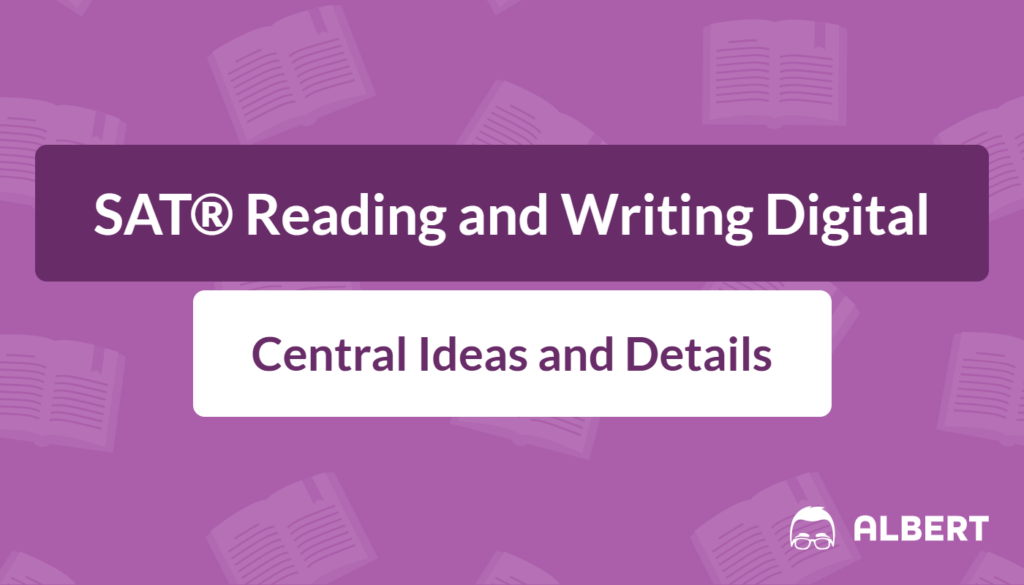What We Review
Understanding the Central Idea in SAT® Reading and Writing
Reading comprehension on the SAT® can feel challenging at first. However, identifying the central idea of a passage makes the entire process easier. This skill enhances understanding and boosts overall test performance. Therefore, learning to spot the main point quickly helps students answer questions about supporting details, themes, and underlying messages.
Below is a clear guide on how to find the central idea and back it up with strong evidence. With these tips, test-takers can sharpen their analysis and reasoning skills and approach the SAT® Reading and Writing section with greater confidence.
What Is a Central Idea?
The central idea is the main point or message that an author wants readers to remember. It is often the “big picture” or the core statement around which all other points revolve. Writers may not always state this idea directly, but it is usually implied through the text’s overall direction.
Importance:
- It shapes how the passage is interpreted.
- It helps readers understand why the author wrote the text.
For instance, if a passage discusses the importance of preserving local forests, the central idea might be, “Conserving natural habitats is crucial for environmental stability.” When test-takers identify this main point, they can more easily see how each paragraph or example supports it.
How to Identify the Central Idea
Recognizing the central idea can be simple if a reader knows what to look for. There are three main features that often signal the core message:
1. Themes and Topics
- Scan the passage to see the recurring themes or topics.
- Look for repeated words or ideas.
2. Repetition of Ideas
- Notice similar statements made throughout the text.
- Repeated messages often indicate the main focus.
3. Summary Statements
- Pay attention to the introduction or conclusion.
- Sometimes, the central idea is directly hinted at or summarized there.
Identifying Central Ideas in Different Text Types
Narrative Texts:
- Look for the storyline’s main conflict or moral.
- Observe how characters or events drive the author’s message.
Informational Texts:
- Examine the headings or topic sentences.
- Determine how facts and data support a core argument.
Argumentative Texts:
- Identify the primary claim.
- Seek out the stance the author wants readers to accept.
Example: Finding the Central Idea
Passage:
“Many community gardens enrich neighborhoods by providing fresh produce and a place for neighbors to work together. They also serve as a teaching tool for children, who learn about healthy eating and sustainable practices. In essence, these gardens demonstrate that small collective efforts can foster big community benefits.”
Step-by-Step Solution:
- Read the passage carefully and note its main subject (community gardens).
- Observe repeated ideas, such as “enrich neighborhoods,” “fresh produce,” and “place for neighbors to work together.”
- Look at the summary statement: “These gardens demonstrate that small collective efforts can foster big community benefits.”
- Conclude that the central idea is: “Community gardens have a positive impact, both nutritionally and socially, on local neighborhoods.”
Supporting Details: What Are They?
Supporting details are the facts, examples, or explanations that reinforce the central idea. They serve as the foundation for the main point. They provide evidence and clarity, helping readers understand why the central idea is valid.
Examples of Supporting Details:
- Specific data or statistics.
- Quotes from experts.
- Real-life anecdotes or personal stories.
- Descriptions of events or scenarios.
These details show readers why they should accept or agree with the passage’s central idea.
How to Recognize Supporting Details
In most passages, supporting details are found in the body paragraphs. They may appear as short examples or extended discussions. Therefore, always read each paragraph with a focus on how it backs up the main point.
Indicators:
- Examples: A story or personal experience that highlights the main claim.
- Statistics: Numbers or percentages that show evidence.
- Anecdotes: Brief narratives illustrating the topic.
- Quotes: Statements from experts or witnesses.
Example: Identifying Supporting Details
Sample Paragraph:
“City parks not only beautify a region but also improve public health. A recent study found that neighborhoods with more green spaces have lower rates of obesity and heart disease. Moreover, local park-goers often report reduced stress and higher satisfaction with their environment.”
Step-by-Step Solution:
1. Identify the central idea: “City parks benefit health and aesthetics.”
2. Scan for evidence.
- “A recent study found neighborhoods with more green spaces have lower rates of obesity and heart disease.” (Statistic)
- “Park-goers often report reduced stress.” (Anecdote or reporting from individuals)
3. Conclude that these facts and examples directly support the central idea.
The Connection Between Central Ideas and Supporting Details
Central ideas and supporting details work together. The main idea gives readers the big picture, while the details explain or prove that idea. Therefore, readers should never view the central idea alone. Instead, consider how the writer uses evidence to build a convincing argument.
Well-Supported Central Idea:
- Enhances reader understanding.
- Adds credibility to the writer’s message.
- Makes the argument persuasive and memorable.
When a text has strong supporting details, the central idea stands out and feels more reliable.
Tips for Mastering Central Ideas and Supporting Details
These strategies help students approach passages with confidence:
1. Preview the Text

- Skim the title, subheadings, or bold words.
- Make a quick guess about the central theme before reading.
2. Annotate While Reading
- Underline or highlight main points.
- Jot down quick notes on specific examples or quotes.
3. Summarize After Reading
- Write a brief sentence stating the central idea.
- List key details that support that idea.
Practice Question
Read the brief paragraph below, then identify its central idea and at least two supporting details:
“Technology-based learning tools have gained popularity in recent years. Many teachers report that student participation increases when using interactive apps during classroom lessons. Additionally, some studies suggest that visual learners thrive with multimedia presentations. Because of this, schools worldwide are exploring new and more creative digital platforms.”
Step-by-Step Solution:
1. Read the paragraph to find the main focus: “Technology-based learning tools have gained popularity.”
2. Look for repeated evidence:
- “Student participation increases when using interactive apps.”
- “Visual learners thrive with multimedia presentations.”
3. Formulate the central idea: “Technology-based learning tools are becoming widespread because they engage students effectively.”
4. Supporting details:
- Teacher reports of increased participation.
- Studies suggesting visual learners benefit from these tools.
Quick Reference Chart
Below is a handy vocabulary chart regarding central ideas and supporting details. Copy and paste this table into a document for quick review:
| Term | Definition or Key Feature |
| Central Idea | The main point or core message the author wants readers to grasp |
| Theme | The overarching subject or recurring topic in a text |
| Supporting Detail | Evidence (statistics, quotes, anecdotes) that strengthens the central idea |
| Narrative Text | A passage that tells a story, often focusing on characters and plot |
| Informational Text | A non-fiction passage offering facts and data on a specific topic |
| Argumentative Text | A passage presenting a claim with reasons and evidence, aiming to persuade |
| Summarizing | Condensing the passage into its main points, focusing on the central idea and key details |
| Annotating | Marking important points, keywords, or themes in the text for deeper understanding |
Conclusion
Mastering the skill of identifying central ideas and details is essential for success on the SAT® Reading and Writing section. Therefore, students should practice reading passages from various genres and summarizing their core points.
Strong central ideas become clearer when readers notice how supporting details support the primary themes. This focus not only leads to better performance on test day but also improves everyday reading comprehension and critical thinking.
For more guided practice, try reading news articles, literature excerpts, or scientific reports and then summarizing their main ideas. Additionally, consider checking out official SAT® practice materials and study guides, which offer full-length tests and expert tips. By integrating these skills into daily reading habits, students can steadily develop the ability to locate, interpret, evaluate, and integrate information and ideas, ensuring a higher score in the SAT® Reading and Writing section.
Sharpen Your Skills for SAT® Reading and Writing
Are you preparing for the SAT® Reading and Writing test? We’ve got you covered! Try our review articles designed to help you confidently tackle real-world SAT® Reading and Writing problems. You’ll find everything you need to succeed, from quick tips to detailed strategies. Start exploring now!
- Textual Evidence: SAT® Reading and Writing Review
- Quantitative Evidence: SAT® Reading and Writing Review
- Inferences: SAT® Reading and Writing Review
Need help preparing for your SAT® Reading and Writing exam?
Albert has hundreds of SAT® Reading and Writing practice questions and full-length practice tests to try out.








